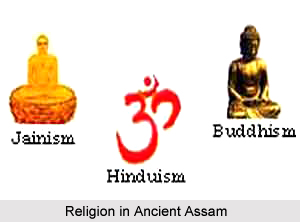 Religion in Ancient Assam consists of Hinduism Religion, Jainism and Buddhism. Animistic beliefs have laid the foundation of Religion in ancient Assam. The advent and systematic settlements of the Brahmins in early Assam have detribalized the religious cults of the tribes of this region. The geographic origin of archaeological remains of early Assam reveals that the pantheons such as Brahmanical, Buddhist and Jaina faiths existed.
Religion in Ancient Assam consists of Hinduism Religion, Jainism and Buddhism. Animistic beliefs have laid the foundation of Religion in ancient Assam. The advent and systematic settlements of the Brahmins in early Assam have detribalized the religious cults of the tribes of this region. The geographic origin of archaeological remains of early Assam reveals that the pantheons such as Brahmanical, Buddhist and Jaina faiths existed.
The systematic land grants had given birth to some pockets of Brahmanical culture, which merged as epicentres of Brahmanical beliefs. Several ruins of temples of Lord Shiva have been discovered, sculptures of Shiva and the Shiva lingam in different parts of the Guwahati city, North Guwahati and nearby areas reflects the status of the Shaivam.
Hinduism in Ancient Assam
According to Kalika Purana Lord Siva was the guardian deity of the land before the beginning of Devi worship in Kamakhya. The rulers of Pragjyotisha-Kamarupa trace their descent from Lord Vishnu. The story of advent of Naraka depicted in the Kalika Purana and the Vishnu Purana shows the popularity of Vaishnavism.
The Kalika Purana has also enumerated some popular centres of Vishnu worship of ancient Assam. The centres of Vishnu worship are Lord Hayagriva, worshipped on Manikuta, Matsa worshipped in the Matsyadhvaja mount to the east of Manikuta and Pandunatha, to the east of the Raksahkuta hill.
Shaktism was also a popular religious belief in Assam. The Kamakhya temple of Guwahati was originally a local tribal cult worshipped as Mother Goddess by Khasi and the Garo Tribes. The Sculptures of Surya are found at Sukreswar temple, Narakasura hill, Ambari, Navagraha temple, Chayagaon, Sualkuchi reveal about the prevalence of the Surya cult in the region.
The discovery of one rock-cut image of Lord Indra at Pandu near Chatrakara temple of Guwahati give a proof that Indra, the Lord of Heaven was also worshipped in some parts of Assam. Brahmanical faiths were prevalent in the Goalpara District. The Shaivaite faith was prevalent in Tezpur region. The prevalence of the Shakti cult in the Tezpur region is revealed from the literature and epigraphs of early Assam.
Religion in ancient Assam witnessed a change began from the 7th century onwards that was marked by absorption of the Brahmanical Shakti-Tantricism with the Buddhist-Tantrism form. Sun god, Navagrahas, Lord Ganesha were worshipped in the Tezpur region.
Many temples of Nagaon District belong to the Shaiva sect. The prevalence of Shakti cult in the Nagaon region have been discovered through various images of Mahakali, Uma- Maheswara, Tripura-Bhairavi, Ardhanariswara, Simhabahini- Goddess Durga, Mahishamardini, Chamunda.
The ruins of Lord Ganesha temple have been discovered at Mahadeoshal, Kawaimari, Devasthan. Several rock cut images of Lord Ganesha have been discovered. Minor deities like Kartikeya, Lord Indra, Kubera, Lord Agni, Goddess Lakshmi and Goddess Saraswati were also worshipped
Buddhism in Ancient Assam
The episode of Amritaprabha in the Rajatarangini of Kalhana also supports the prevalence of Buddhism in Kamarupa. Some pockets of Buddhism were places like Jogighopa, Pancharatna, Surya Pahar, Vadagokugiri where the Buddhist stupas and caves have been discovered. The existence of Mahayana Buddhism at Surya Pahar during the rule of Pala dynasty is proved by the terracotta plates. It bear the two rows of stamped images of Bodhisattvas.
Vajrayana, the Tantric form of Buddhism had emerged as popular religious belief in the first millennium AD in Assam. Hajo and Kamakhya were the prominent centres of the Mahayana and the Tantric-Buddhism in Guwahati region. The circular shrine also known as Medhghar situated at Chayagaon in the Kamrup district is an ancient centre of Buddhism. Under Rahulabhadra`s influence, the king Ratnapala was converted to Vajrayana Buddhist. In the Goalpara District, also Tantric form of Buddhism had developed in the later part of the Pala period. The Nagaon region also emerged as a popular seat of Tantric-Buddhism.
Jainism in Ancient Assam
Jainism however could not create a firm ground in early Assam. Two images: one of Rishabhanatha and one of Lord Neminath were discovered at Surya Pahar of Goalpara indicates that Jainism existed.






